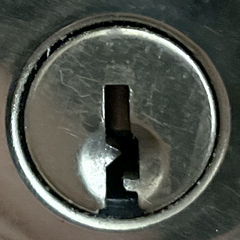Weiser Classic: Difference between revisions
From Lockwiki
Jump to navigationJump to search
m (added image of deadbolt/logo) |
|||
| (5 intermediate revisions by 2 users not shown) | |||
| Line 1: | Line 1: | ||
<span style="font-size:22px">Weiser</span> | |||
---- | |||
{{Lock model | {{Lock model | ||
|name=Weiser | |name=Weiser (standard) | ||
|Img= | |Img=File:Weiser_keyway-ZachWillard.png | ||
|maker=[[Weiser]] | |maker=[[Weiser]] | ||
|lock_type=[[Cylinder]] | |lock_type=[[Cylinder]] | ||
|lock_design=[[Pin-tumbler]] | |lock_design=[[Pin_tumbler |Pin-tumbler]] | ||
|related= | |related= | ||
|patent= | |patent= | ||
|years_produced= | |years_produced= | ||
| spec_on = true | |||
| spec_comptype = [[Pin_tumbler |Pin-tumbler]] | |||
| spec_comp = 5 | |||
}} | }} | ||
The standard cylinder made by [[Weiser]] is a [[Pin_tumbler |pin-tumbler]] lock. | |||
The | |||
__TOC__ | __TOC__ | ||
<br clear=all> | |||
== Principles of operation == | == Principles of operation == | ||
:''See also: [[ | :''See also: [[Pin_tumbler#Principles_of_operation|Pin-Tumbler (Principles of operation)]]'' | ||
The | The standard Weiser cylinder is a traditional pin-tumbler that uses five pin stacks. To open the lock, all pin stacks must be aligned at the [[shear line]] to allow the [[plug]] to rotate. There are ten key pin heights and eleven key cut depths with the use of [[Master keying|master pins]]. | ||
== Keying Specifications == | == Keying Specifications == | ||
| Line 54: | Line 59: | ||
{| border="1" cellpadding="5" cellspacing="0" | {| border="1" cellpadding="5" cellspacing="0" | ||
|- bgcolor="#e0e0e0" | |- bgcolor="#e0e0e0" | ||
| '''Key Blank''' || '''Effective Plug Diameter''' || '''Shoulder to First Cut''' || '''Root | | '''Key Blank''' || '''Effective Plug Diameter''' || '''Shoulder to First Cut''' || '''Root to Root''' || '''Depth Increment''' || '''Cut Width''' || '''MACS''' | ||
to Root''' || '''Depth Increment''' || '''Cut Width''' || '''MACS''' | |||
|- | |- | ||
| 1054WB, WR3 || .483" || .237" || .156" || .018" || .090" || 6 | | 1054WB, WR3 || .483" || .237" || .156" || .018" || .090" || 6 | ||
|} | |} | ||
== Disassembly instructions == | == Disassembly instructions == | ||
The | The standard cylinder can be disassembled with the typical pin-tumbler disassembly method. The design of the | ||
pin-chamber casing facilitates quick disassembly and full rekeying. | pin-chamber casing facilitates quick disassembly and full rekeying. | ||
| Line 77: | Line 79: | ||
== Vulnerabilities == | == Vulnerabilities == | ||
The | The standard lock may be vulnerable to one or more of the following: | ||
* [[Lockpicking]] | * [[Lockpicking]] | ||
| Line 88: | Line 90: | ||
<div align="center"><gallery> | <div align="center"><gallery> | ||
File:Weiser_bolt_logo-ZachWillard.png |The Weiser logo on a deadbolt. | |||
</gallery></div> | </gallery></div> | ||
| Line 96: | Line 98: | ||
== See also == | == See also == | ||
* [[Weiser]] | * [[Weiser]] | ||
* [[Pin-tumbler]] | * [[Pin_tumbler |Pin-tumbler]] | ||
[[Category:Weiser| | [[Category:Weiser| ]] | ||
[[Category:Pin-tumbler locks]] | [[Category:Pin-tumbler locks]] | ||
[[Category:Lock models]] | |||
Latest revision as of 16:19, 12 January 2023
Weiser
| Weiser (standard) | |
 | |
| Name | Weiser (standard) |
|---|---|
| Manufacturer | Weiser |
| Lock Type | Cylinder |
| Lock Design | Pin-tumbler |
| Specifications | |
| # of Components | 5 |
| Component Type | Pin-tumbler |
The standard cylinder made by Weiser is a pin-tumbler lock.
Principles of operation
- See also: Pin-Tumbler (Principles of operation)
The standard Weiser cylinder is a traditional pin-tumbler that uses five pin stacks. To open the lock, all pin stacks must be aligned at the shear line to allow the plug to rotate. There are ten key pin heights and eleven key cut depths with the use of master pins.
Keying Specifications
| Cut | Spacing | Depth | Key Pin | Master | Driver |
| 0 | n/a | .315" | .168" | n/a | .185" |
| 1 | .237" | .297" | .186" | n/a | .185" |
| 2 | .393" | .279" | .204" | .036" | .185" |
| 3 | .549" | .261" | .222" | .054" | .185" |
| 4 | .705" | .243" | .240" | .072" | .185" |
| 5 | .861" | .225" | .258" | .090" | .185" |
| 6 | 1.017" | .207" | .276" | .108" | .185" |
| 7 | n/a | .189" | .294" | .126" | .185" |
| 8 | n/a | .171" | .312" | .145" | .185" |
| 9 | n/a | .153" | .330" | .160" | .185" |
| Key Blank | Effective Plug Diameter | Shoulder to First Cut | Root to Root | Depth Increment | Cut Width | MACS |
| 1054WB, WR3 | .483" | .237" | .156" | .018" | .090" | 6 |
Disassembly instructions
The standard cylinder can be disassembled with the typical pin-tumbler disassembly method. The design of the
pin-chamber casing facilitates quick disassembly and full rekeying.
- Remove the cam or C-clip.
- Insert the key and turn the plug 45-90 degrees.
- Withdraw the plug from the cylinder. (A plug follower is recommended)
OR
- Remove the chamber casings and take out each pin-stack individually
- Remove the cam or C-clip.
- Withdraw the plug from the cylinder.
Removing cylinders from Weiser knobs
- Pull back on the spindle while rotating the cylinder plug.
- Pull the cylinder from the front of the knob.
Vulnerabilities
The standard lock may be vulnerable to one or more of the following:
Gallery
References
